St George's Anglican Church
Lucknow Street, Travancore
Built Robert Mackenzie 1875 for Christ Church, Castlemaine
Installed Baptist Church, West Melbourne after 1888
Installed 1962 Baptist Church, Greensborough Harry Marriner
Installed present location 1981 Robert Heatley
Renovated 2014-15 Hargraves Pipe Organs
1 manual, 7 speaking stops, 1 coupler, mechanical & tubular pneumatic action.
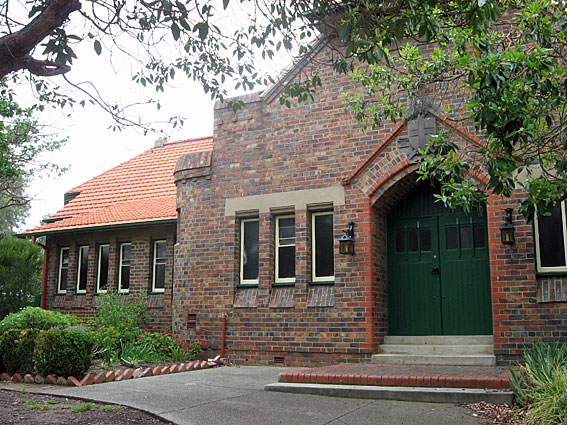
St George's Anglican Church, Travancore: the transept façade
[photograph by Ken Falconer (17 December 2008)]
Historical and Technical Documentation by John Maidment
© OHTA, 2012, 2015 (last updated January 2016)
St George's Church was built in 1925-6 to the design of accomplished church architect Louis R. Williams. Williams' initial design, dating from 19 September 1924, envisaged a large new church with tower, church hall and vicarage.1 However, the church was never built and a combined church and hall now serves as the church. There is a jerkin-head gable projecting over the belfry and rectilinear windows below.2 The exterior is notable for its meticulous brickwork, the whole with a pronounced late arts and crafts feeling. The brick-faced interior includes a two-bay arcade to the left and an apsidal sanctuary with overscaled roof trusses.
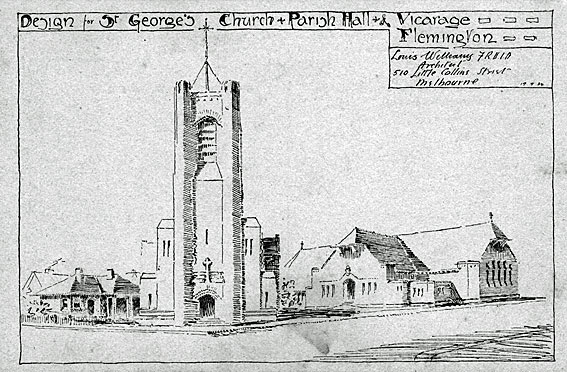
St George's Church, Flemington (Travancore): Louis R. Williams' design of 19 September 1924
[photograph by John Maidment (27 February 2012)]
This organ is almost certainly that built by Robert Mackenzie & Co of Melbourne for Lee & Kaye and installed at Christ Church, Castlemaine in August 1875.3 This instrument was replaced at Castlemaine by a larger organ built by George Fincham that was installed in 1888. The Mackenzie organ is understood then to have been moved to the Baptist Church, West Melbourne. It was later moved to the Baptist Church, Greensborough in 1962, probably by Harry Marriner, and moved to its present location in 1981 by Robert Heatley.
A description of the organ appeared in the Mount Alexander Mail for 24 August 1875:
The greater portion of the new organ for Christ Church (CE) was delivered yesterday. The instrument is what is called a 'manual' and contains eight stops, viz. open diapason (bass) ditto (treble), viol de Gamba, principal, flute and fifteenth, besides which there is one coupler and bourdon pedal of two octaves, three composition pedals, all enclosed in a general swell. The pipes in front are what are termed 'illuminated' and the case stained and varnished. It has been supplied by Lee and Kaye and built by R. McKenzie and Co., of Melbourne and as a guarantee of it being a first class instrument it may be mentioned that the same gentleman built the great organ in the Town Hall Melbourne.
This instrument closely resembles another instrument attributable to Mackenzie (St Monica's Catholic Church, Footscray). Robert Mackenzie was working in Melbourne from 1872 to around 1880. Regrettably, the nameplate has been removed. The casework of this instrument and the one at Footscray is close to identical, while the console and its supporting brackets is very similar to the 1872 Hill & Son organ now at St Augustine's Catholic Church, Yarraville, which Mackenzie would have known through his association with the Hill firm. The metal pipework is of plain metal and this and the wooden pipework has written note designations in Hill style. The side panels have been extended backwards to accommodate the Bourdon, but as the reservoir extends into this area, it is likely to have happened at the time of construction; or the side panels may have been secondhand. Many of the internal action components are constructed from oak, which is an unusual choice for an Australian organbuilder.
The following alterations have been made to the original organ:
- The two turned wooden finials surmounting the case posts have been sawn off (possibly to accommodate the organ under a low ceiling height);
- The transom rail and supporting carved brackets have been removed – evidence for the latter may be found in screw holes on the case posts); the transom rail has been replaced;
- The mechanical action to the Pedal Bourdon has been replaced with tubular-pneumatic using plastic tubing (carried out in 1962 by Harry Marriner, who presumably moved the organ to Greensborough);
- Several stop labels have been replaced with non-matching engraving and incorrect names (in 1981?);
- Tuning slides have been placed on the enclosed metal pipework.
The instrument has been cleaned and overhauled by Hargraves Pipe Organs Pty Ltd 2014-2015 who have also carried out the following work under the auspices of an OHTA-sponsored restoration appeal:
- Fitting of a new silent Laukhuff blower;
- Removal of paint from the plain metal facade pipes (revealing traces of the original decoration etched into the metal) and gilding of the pipe mouths;
- Replacement of the turned case finials and carved brackets, based upon those at St Monica's, Footscray.4
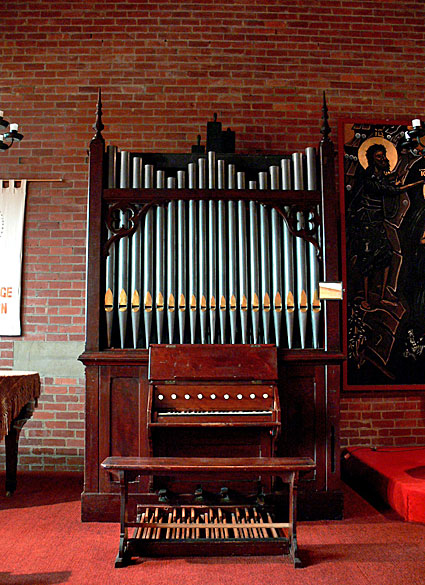
St George's Church, Travancore: the organ, viewed from the nave, showing new case finials and carved brackets
[John Maidment (6 January 2016)]
| MANUAL | ||
|---|---|---|
| Open Diapason | 8' | TC unenclosed |
| Bass St Diapason | 8' | CC-BB |
| Treble St Diapason | 8' | TC |
| Keraul'on | 8' | TC (replacement label, previously Viol di Gamba 8') |
| Principal | 4' | |
| Flute | 4' | TC (replacement label) |
| Fifteenth | 2' | |
| Manual to Pedal | ||
| Tremulant | (added later) |
| PEDAL | ||
|---|---|---|
| Bourdon | 16' |
Compass: 56/25
3 composition pedals
Trigger swell lever
Mechanical manual and stop action; tubular-pneumatic pedal action5
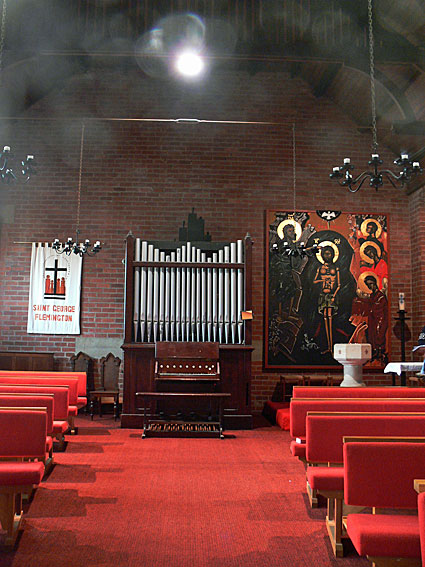
St George's Church, Travancore: the organ, viewed from the nave before the renovation work
[photograph by John Maidment (11 August 2012)]
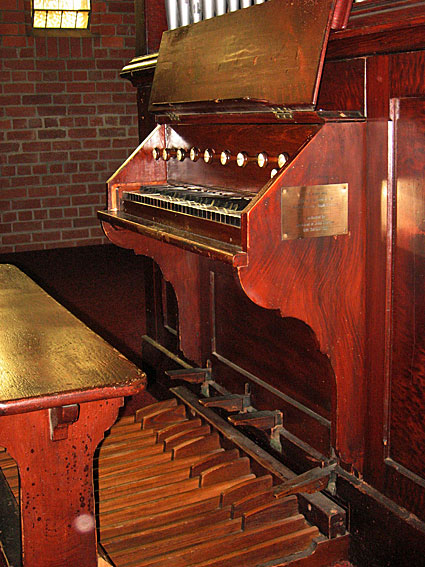
St George's Church, Travancore: console
[photograph by Ken Falconer (17 December 2008)]
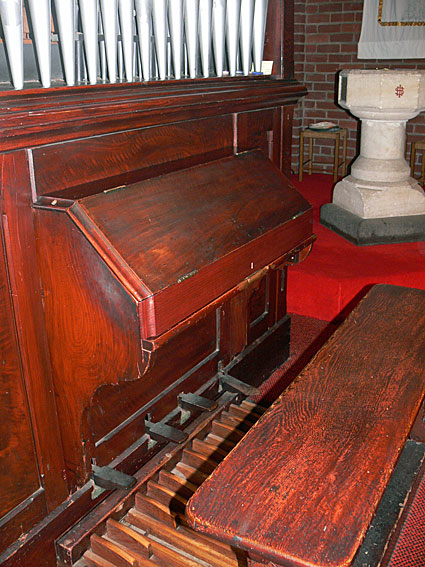
St George's Church, Travancore: the console in closed position
[photograph by John Maidment (11 August 2012)]
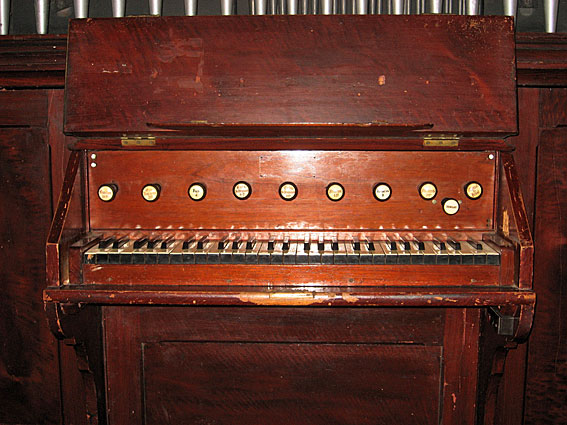
St George's Church, Travancore: drawstops
[photograph by Ken Falconer (17 December 2008)]
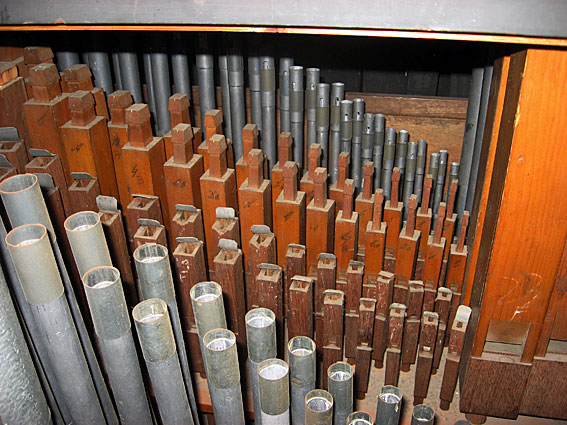
St George's Church, Travancore: internal pipework
[photograph by Ken Falconer (17 December 2008)]
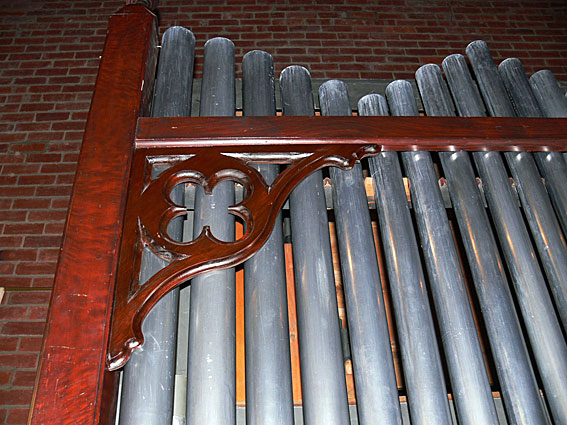
St George's Church, Travancore: detail of one of the reconstructed carved brackets
[photograph by John Maidment (6 January 2016)]
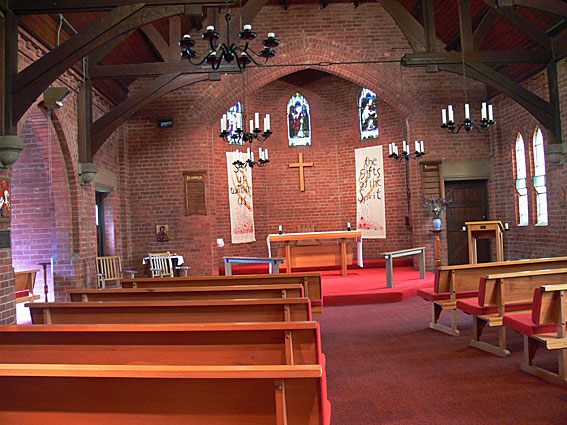
St George's Church, Travancore: the church interior
[photograph by John Maidment (11 August 2012)]
1 Postcard issued by Louis R. Williams in the collection of John Maidment
2 Victorian Churches, edited by Miles Lewis. East Melbourne; National Trust of Australia (Victoria), 1991, p.54.
3 Mount Alexander Mail, 24 August 1875 cited in Christ Church Castlemaine a History of the Organs at Christ Church
4 Details noted John Maidment from images supplied by Ken Falconer and inspection 11 August 2012 and further information supplied by Campbell Hargraves to Geoffrey Cox June 2015 and inspection by John Maidment 6 January 2016.
5 Specification noted John Maidment 1967 with stop nomenclature updated from images supplied by Ken Falconer